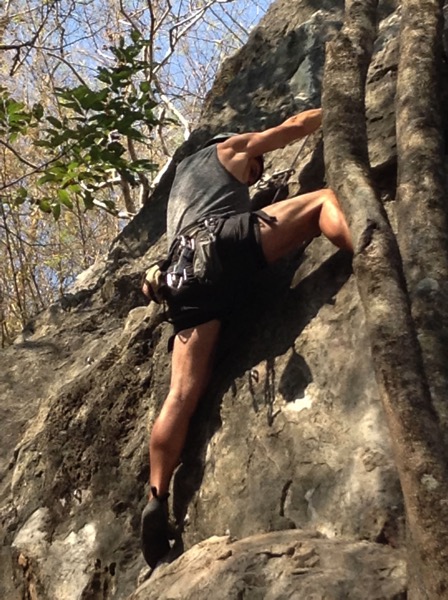Day 46: Fear of Falling

It’s usually called fear of heights. But heights themselves don’t really bother me: I can look out of airplane windows without worrying. Zip lining triggers no fear. As long as I feel securely attached or enclosed I remain relaxed.
But bring in the possibility — however remote — of falling and my anxiety spikes. A cliff edge without a bannister. Floor-to-ceiling windows in a skyscraper. A wobbly suspension bridge. They tempt my mind to think about slipping, grasping frantically at an edge. Scrambling to avoid the fall. The weakening and falling. More and more I get stuck in that imaginary loop until any movement feels soaked in crushing risk. Every footfall will inevitably slip. It’s like the empty space is pulling me; there’s a horrible feeling that only jumping will relieve the stress.
Over the years, I’ve tried to take the edges off my fear: hiking and scrambling on mountains. Bouldering in a climbing gym.
Roped climbing is a particularly interesting test for the fear. You’re roped in and “safe” — safer even than walking along a cliff edge. But you don’t feel the rope holding you. At least not until you fall. So for me, the fear remains. Especially so given exposure: the air beneath your feet, the knowledge that you’re clinging to a rock face with your hands and feet.
Regardless — or perhaps because — of the fear, I’ve always wanted to get out of the gym and try climbing a real wall. So Kristen and I went to the Crazy Horse Buttress right outside of Chiang Mai on a climbing tour to have a try. The guides, Peet and Wen were friendly and led the routes up so we could top rope the easiest ones. Other than that, we were left to our own devices when it came to technique.
The crag was spectacular, rising several hundred feet out of the rural countryside. The rock was solid and in places quite sharp. A superb introduction to the sport.
 Arriving at the base, the first thing I noticed was that the wall was swarming with bees. This species was interesting: they built these spires of wax coming out of the rock. Nervous around them at first, Wen reassured me that they didn’t sting. Just like the climbing: they’re scary, but there’s no real danger. You hope.
Arriving at the base, the first thing I noticed was that the wall was swarming with bees. This species was interesting: they built these spires of wax coming out of the rock. Nervous around them at first, Wen reassured me that they didn’t sting. Just like the climbing: they’re scary, but there’s no real danger. You hope.
We went up four routes. Two in the morning and two in the afternoon. They were likely the easiest routes on the face, but they were nevertheless great fun and a significant challenge.
The first two were on the Crazy Horse face, climbed before lunch. They were easy, but I don’t know their names. They’re probably 2 of these, likely including the 5.7 one, Rope and Rock:
[
 ](http://www.rockclimbing.com/routes/Asia/Thailand/Northern_Provinces/Crazy_Horse_Buttress/Crazy_Horse_Buttress/)
](http://www.rockclimbing.com/routes/Asia/Thailand/Northern_Provinces/Crazy_Horse_Buttress/Crazy_Horse_Buttress/)
The PM routes are easier to identify from the description and the fact there are only two in my skill range:
- Easy Bake Over 5.8
- Sideshow 5.9
 Because of the state of mind this traveling has put me in, I can’t help but notice some of the more obvious metaphors in this sport.
Because of the state of mind this traveling has put me in, I can’t help but notice some of the more obvious metaphors in this sport.
- For these simple bolted top-roped routes, you can never get completely blocked. There’s always a path upward. This feels like life right now. The next hold is always apparent and rarely all that difficult to grasp
- Inevitably when I was stopped and couldn’t find the next hold, the beta (climbing slang for hints) given by the guides was the same: it would be to go in the direction I most feared. “but I don’t want to go there” I’d whine. The blankest part of the wall. The scariest foothold
- The big picture doesn’t help you, even though it seems very important. Looking down is just terrifying. Looking up is daunting. Focus on where you are
- Being completely focused is easy when you’re right on the edge of your ability. The fear helps too of course, but maybe that’s simply another aspect of being at the edge
- It’s best to be just thrown in without a bunch of lengthy training. The guides didn’t tell us where to go unless we asked and taught us no technique. Even the all-important figure 8 knot which ties your harness to the rope was given the briefest explanation. It was easier for me with my experience, but even Kristen remarked how this way is better. Now that we have experience with it, we can ask real questions. Often teaching is devolves to answering questions before the student even knows the point to asking
The freedom you feel in climbing is incredibly attractive. Being able to ascend a rock face that looks un-climbable. The joy of moving your weight in delicate maneuvers to position for the next surge upwards. But it’s the small victories over fear that are the most wonderful part of it for me. A lab of sorts where you can practice being a little braver than you are.
